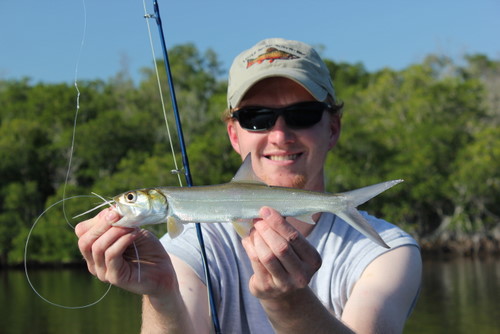Snook are ambush predators, lurking around mangrove roots and waiting for baitfish to come by. Brown trout lay just out of current and I figured snook might do the same. The second day of the trip dawned bright and promised to be very warm. We loaded the canoes and I strung the fly rod together, deciding to start with a white stealth bomber (tricked out with flash and rubber legs). I'm learning to really appreciate the noise making ability of this fly. Furthermore, it dives and swoons in the water, looking just like a struggling baitfish or something else that is edible.
As we got under way with the day's paddle, I really wanted to get my first fish out of the way so I could relax. Not knowing what else to do, I started thinking in terms of brown trout. Paddling towards a creek that led to the next large bay, I noticed the tide had started moving in. The current was moving around a distinct point just ahead, creating a seam between fast and slow water. "Perfect," I thought and picked up the rod to cast.
Amazingly, it only took about 5 casts to get that first fish. As I fought it closer to the boat I saw that it was a snook! Not a large fish, but a snook nonetheless. Two years ago, estimates say that 70% of the snook in the Glades area were killed by the extremely cold winter. I knew that meant the majority of the fish I did find would be smaller fish. Since I've never caught any, I didn't care if they were small or large. I was just happy to be catching fish.
Catherine McGrath Photograph
Shortly after the snook, I found a school of ladyfish and had fun catching a few before it was time to paddle on. As the trip wore on, I would become frustrated with the ladyfish because they were hard to keep off my flies. Still, it is better to be catching something than to be going fishless...
Catherine McGrath Photograph
More fishing opportunities awaited deeper in the Everglades. But in the meantime we had a brutal paddle ahead to reach our next campsite. I put down the fly rod, not to take it up again until evening.





















